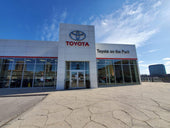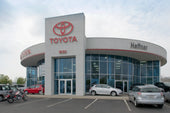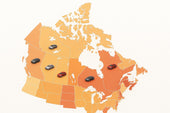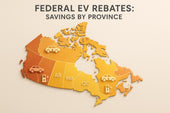Buying a car in Canada can be challenging, with hidden fees, confusing pricing, and pressure tactics often complicating the process. To save money and avoid unnecessary costs, you need to understand dealer pricing, negotiate effectively, and use tools that provide access to dealer invoice prices and discounts.
Key Takeaways:
- Dealer Pricing Basics: MSRP is the starting price, but the invoice price (what dealers pay) is lower. The difference is the dealer's profit margin, which can often be negotiated.
- Hidden Fees: Watch for add-ons like documentation fees, extended warranties, and protection packages. Many are optional or negotiable.
- Timing Matters: Buying at the end of the month, quarter, or year can lead to better deals as dealerships aim to meet sales targets.
- Transparent Pricing Tools: Platforms like Price Driven provide invoice pricing, factory discounts, and pre-negotiated deals, helping you save time and money.
Quick Tips for Negotiation:
- Research the invoice price and market incentives for your desired vehicle.
- Get written quotes from multiple dealerships to create competition.
- Negotiate the car price first, then handle add-ons and financing separately.
- Use pre-approved financing and trade-in values as leverage.
- Review all paperwork carefully to ensure terms match your agreement.
How To Negotiate THE BEST Deal With The Car Dealer (Step By Step) In 2025
How Dealer Pricing Works in Canada
Understanding how dealerships price vehicles is a key step in getting a fair deal. The pricing structure includes several layers that influence what you’ll end up paying. Knowing these details can give you an edge during negotiations.
MSRP, Invoice Price, and Dealer Markups Explained
The MSRP (manufacturer’s suggested retail price) is essentially a starting point - it’s the price the manufacturer recommends dealers charge. However, it’s not the whole story.
The invoice price is what the dealer actually pays the manufacturer for the vehicle, and it’s usually lower than the MSRP. This price can include hidden incentives or discounts that aren’t obvious to buyers. The difference between the MSRP and the invoice price is where the dealership’s profit comes from - this is known as the dealer markup.
In Canada, the markup varies depending on factors like vehicle demand and market conditions. Popular models that are in high demand often leave little room for negotiation. On the other hand, vehicles that aren’t selling as quickly may offer more flexibility, as dealerships are eager to clear inventory.
Understanding the invoice price allows you to negotiate with confidence. Instead of starting from the higher MSRP, you can focus on a realistic range. But it’s not just about the base price - dealerships often tack on additional fees and services that can inflate your final cost.
Common Hidden Fees and Add-Ons to Watch For
Many Canadian dealerships add extra fees and services that can significantly increase what you’ll pay. For example, documentation fees - which typically range from $300 to $800 - are a common addition.
Dealerships may also try to upsell extras like extended warranties, service plans, and protection packages. These add-ons can easily add thousands of dollars to your purchase price.
Here’s the thing: many of these fees and add-ons are negotiable or even optional, despite being presented as mandatory. You can often decline or negotiate them separately. Always ask for a detailed breakdown of all fees and ensure the dealership explains what each charge covers. In some cases, fees can be reduced or even waived if you negotiate effectively. By understanding both base pricing and these additional costs, you’ll be better equipped to make informed decisions.
How Transparent Pricing Tools Help Buyers
Once you understand base prices and hidden fees, transparent pricing tools can help you take control of the negotiation process. These tools give Canadian buyers access to crucial information like invoice prices, dealer discounts, and market trends - data that was once only available to dealerships.
For example, platforms like Price Driven provide access to dealer invoice pricing, along with details about factory discounts and incentives. Their free reports reveal rebates and other offers for specific vehicles, giving you a clear picture of what’s negotiable.
Armed with this data, you can base your offers on actual market figures, making it easier to identify competitive deals. The results speak for themselves: Price Driven users saved an average of over $700. In an April 2025 report, 26 out of 32 users saved more than $700, and 30 out of 32 reported a better experience at the dealership.
Some tools even go a step further by offering pre-negotiated pricing with partner dealerships, simplifying the entire process. By using these tools before stepping into a dealership, you’ll walk in with solid data to back up your negotiation, increasing your chances of landing a better deal.
How to Prepare for Dealer Negotiations
Getting ready for dealer negotiations involves doing your homework on pricing, incentives, and market trends. With the right preparation, you can approach the process with confidence and a solid understanding of what to expect.
Research Market Prices and Incentives
Start by gathering pricing information for the specific make, model, and trim you're interested in. Don’t just stop at the MSRP - dig deeper to uncover the invoice price and current market value. Tools like Canadian Black Book can give you accurate market valuations, while browsing dealership listings across provinces can reveal regional price differences.
Manufacturer incentives are another key factor to research. These can significantly reduce your final cost and may include cash rebates, low-interest financing, loyalty rewards, or seasonal promotions. To find these deals, visit automaker websites and compare both national and provincial offers.
Use Discount Reports and Pre-Negotiated Pricing Tools
While traditional research is helpful, platforms like Price Driven provide an extra layer of insight. They offer free discount reports that detail dealer invoice pricing, factory discounts, and even hidden incentives that aren’t always public knowledge. This kind of transparency lets you negotiate based on actual dealer costs rather than relying on estimates.
Some platforms also provide access to pre-negotiated pricing through partner dealerships. This can save you the hassle of lengthy negotiations while ensuring clear pricing and terms. With this information in hand, you can quickly evaluate whether a dealer’s offer is genuinely competitive.
Timing Your Purchase for Better Deals
Timing matters when it comes to saving money. Dealerships often aim to meet sales targets on a monthly, quarterly, and annual basis, making them more flexible during these periods.
The end of the month is particularly effective, as sales managers are often eager to close deals to hit quotas. This urgency increases at the end of quarters and especially at year-end, when dealerships may offer additional incentives to boost their numbers. By timing your purchase strategically, you could save hundreds - or even thousands - beyond standard negotiation discounts.
Special sales events like Boxing Day, Black Friday, and model year-end clearances can also combine manufacturer incentives with dealer discounts. Keep an eye on dealership websites and social media for flash sales or limited-time offers. However, be cautious of pressure tactics like "today only" deals - legitimate discounts usually allow a reasonable window for decision-making.
Being well-prepared with thorough research, pre-approved financing, and a trade-in value ensures you’re ready to act quickly when the right deal comes along. This level of preparation shows dealers that you mean business, often prompting them to offer their best terms right away.
sbb-itb-20f5d75
Proven Negotiation Tactics for Canadian Buyers
With thorough research and preparation, these strategies will help you negotiate effectively and secure a deal that works in your favour.
Get Written Quotes from Multiple Dealers
Start by collecting written quotes from at least two or three dealerships. This simple step creates a sense of competition among dealers, pushing them to offer you better pricing. When dealers know you're considering alternatives, they’re more likely to work harder to win your business.
Reach out via phone or email to request detailed, written quotes. This approach lets you avoid the pressure of in-person negotiations while giving you a clear breakdown of costs, including fees, taxes, and add-ons. Use a spreadsheet to compare the quotes side by side, ensuring that every charge is transparent.
When you approach your preferred dealer with competing quotes, be upfront. Let them know you're weighing your options and ready to buy from the dealership that offers the best overall value. If you have access to invoice data, use it to confidently challenge pricing and spot any hidden markups. After securing competitive quotes, focus on breaking down the costs to understand each part of the deal clearly.
Negotiate Add-Ons Separately from Vehicle Price
Don’t let dealers bundle add-ons with the vehicle price. Bundling often hides the true cost of extras and can inflate the final price. Instead, negotiate add-ons like extended warranties, rust protection, paint sealant, tire and rim protection, and maintenance packages separately. This way, you can evaluate their actual value and decide which ones you genuinely need.
Tackle negotiations step by step: start with the vehicle price, move to financing, and handle add-ons last. This method ensures that discounts on the car itself aren’t offset by inflated prices for extras. If a dealer insists on bundling, politely ask for individual pricing for each component. Be cautious of high-pressure tactics, and remember that many add-ons can be purchased later if you need them.
Use Trade-Ins and Pre-Approved Financing as Leverage
Your trade-in and financing options can be powerful tools in the final stages of negotiation. Begin by researching your trade-in’s value using resources like the Canadian Black Book, and consider getting multiple appraisals to ensure you’re getting a fair deal. Additionally, secure pre-approved financing from your bank or credit union to demonstrate that you’re a serious buyer with the funds ready to go.
Keep your trade-in under wraps until you’ve agreed on the vehicle price. Dealers may adjust their numbers if they know about your trade-in too early. Similarly, pre-approved financing shifts the focus to the total vehicle price, preventing dealers from steering the conversation toward monthly payment amounts. Once the vehicle price is locked in, introducing your trade-in or financing details can often lead to additional perks or better terms.
Completing Your Deal: Final Steps and Review
You've successfully negotiated the price of your vehicle and selected any add-ons you want. Now it’s time to make sure the final paperwork matches everything you agreed upon. This stage is critical, so take your time to review every detail of your contract.
Review Your Purchase Agreement Carefully
Don’t rush through the paperwork - this is your chance to ensure everything is in order. Check that the agreed-upon price, discounts, incentives, and rebates are all clearly documented. Verify that the vehicle details - like the VIN, model, trim, and colour - are accurate. If the dealer made any verbal promises, such as free add-ons, services, or a specific delivery date, make sure these are written into the contract.
Be on the lookout for unexpected fees that weren’t discussed earlier. If you’re trading in a vehicle, confirm that the trade-in value matches what you agreed upon. Pay close attention to financing or lease terms, including the interest rate, monthly payment, and contract length. If you need more time to review the contract, it’s perfectly reasonable to ask to take it home before signing.
Calculate Final Costs Including Taxes and Fees
To avoid surprises, calculate the total "out-the-door" price. Start with the negotiated vehicle price and add all applicable taxes and fees. For instance, in Ontario, you’ll pay 13% HST, while Alberta buyers pay 5% GST. In Québec, you’ll need to account for 5% GST plus 9.975% QST.
Factor in other costs like licensing, registration, tire stewardship fees, and air conditioning excise taxes, along with any add-ons you’ve chosen. Also, confirm the delivery date and ask about conditions for delays. Since incentives or financing rates may change monthly, clarify whether your agreed terms will still apply if the vehicle is delayed. If you’ve paid a deposit, ensure you understand whether it’s refundable if the dealer can’t meet the promised timeline. Using a calculator or spreadsheet can help you double-check all these costs.
Decide Which Add-Ons Are Worth the Cost
Once you’ve nailed down the final price, evaluate any additional options the dealer offers. Make decisions based on your own needs, not what the dealer recommends. Think about your driving habits, how long you plan to keep the car, and what’s already covered under the manufacturer’s warranty.
| Add-On | Typical Cost (CAD) | What It Covers | When It’s Worth It | Expert Insight |
|---|---|---|---|---|
| Extended Warranty | $1,000–$2,500 | Repairs after factory warranty | If keeping the car for more than 5 years | Ideal for long-term ownership |
| Rustproofing | $300–$800 | Corrosion protection | In areas with harsh winters or salty roads | Many modern cars already have protection |
| Paint Protection | $400–$1,000 | Exterior paint finish | If parking outdoors frequently | DIY options can save money |
| Tire & Rim Protection | $400–$800 | Damage to tires/rims | If driving on rough or gravel roads | Check if your insurance already covers it |
| GAP Insurance | $500–$900 | Loan/lease shortfall coverage | If you made a low down payment or have a long loan | Not needed if you made a large down payment |
Many add-ons can be purchased later or through third-party providers at lower prices, so don’t feel pressured to decide on the spot. If an add-on seems useful but pricey, take some time to research alternatives before committing.
For buyers using transparent pricing tools, platforms like Price Driven can simplify this process. These tools offer pre-negotiated deals and detailed cost breakdowns upfront, helping you avoid last-minute surprises and upsells.
If you spot errors or unexpected charges in your paperwork, don’t sign until they’re corrected. Politely point out any discrepancies and request updates to the contract. Remember, you’re under no obligation to sign if you feel pressured or if the dealer won’t make the necessary changes. Walking away is always an option.
Conclusion
Mastering the art of negotiation and leveraging transparent pricing strategies can make car buying in Canada a much smoother experience. By understanding the basics - like MSRP, invoice pricing, and hidden fees - you set yourself up for a fair and informed deal.
Preparation is key. Doing thorough research, obtaining multiple quotes, and timing your purchase strategically can save you hundreds, if not thousands, of dollars. Successful buyers come to the table with clear budgets, pre-approved financing, and a solid grasp of available incentives and rebates.
Thanks to modern tools, the car-buying process has become more transparent than ever. Platforms like Price Driven offer Canadian consumers access to dealer-level discounts, detailed invoice pricing, and pre-negotiated deals - cutting out much of the traditional back-and-forth.
Negotiating effectively means staying informed, assertive, and respectful. Breaking down the process into separate negotiations - whether it's for the vehicle price, financing, trade-ins, or add-ons - helps you stay in control and avoid unnecessary confusion. Always take your time reviewing the final paperwork, and don’t hesitate to walk away if the deal doesn’t meet your expectations.
The Canadian automotive market is full of opportunities for buyers who prepare and use the right tools. Whether it’s your first car or your tenth, blending traditional negotiation strategies with modern transparency tools ensures you drive away with not only a great vehicle but also substantial savings. Keep comparing offers and stay informed to secure the best deal possible.
FAQs
How can I negotiate a better car price in Canada using invoice pricing?
To negotiate effectively using invoice pricing, start by finding out the invoice price of the car you’re considering. The invoice price represents what the dealership pays the manufacturer, giving you a clear starting point for negotiations. Knowing this can highlight how much room there might be for potential discounts.
When you sit down with the dealer, focus on the gap between the invoice price and the MSRP (Manufacturer’s Suggested Retail Price). Politely but firmly, aim for a price closer to the invoice amount. Keep in mind that dealerships still need to cover their operating expenses, so there may be limits to how low they can go. Tools like Price Driven can make this process easier by offering transparent invoice pricing and access to pre-negotiated deals, saving you both time and money.
Approach the negotiation with patience, stay informed, and maintain a respectful tone to secure the best deal possible.
What hidden fees should I watch out for when buying a car from a dealership in Canada?
When buying a car from a dealership in Canada, it’s crucial to watch out for hidden fees that can sneak into the final price. Here are some common ones to keep an eye on:
- Administration fees: These cover the cost of handling paperwork and processing, but the amount can vary significantly from one dealership to another.
- Freight and PDI (Pre-Delivery Inspection): This includes the cost of transporting the car to the dealership and getting it ready for you.
- Extended warranties or protection packages: While these are usually optional, they might be added to your bill without a clear explanation.
Take the time to go through the purchase agreement thoroughly. If anything seems unclear, don’t hesitate to ask for a breakdown. Knowing exactly what you’re paying for can give you the upper hand in negotiations and help you sidestep any last-minute surprises.
How can Price Driven help Canadians get better deals on new cars?
Price Driven simplifies car shopping for Canadians by offering clear invoice pricing, pre-arranged deals, and exclusive dealer discounts on new vehicles. These features allow buyers to understand pricing better and steer clear of unnecessary markups.
The platform also includes free discount reports and an optional paid service that guarantees savings. Thanks to its partnerships with dealerships across Canada, Price Driven helps you secure the best price possible.







































































































































